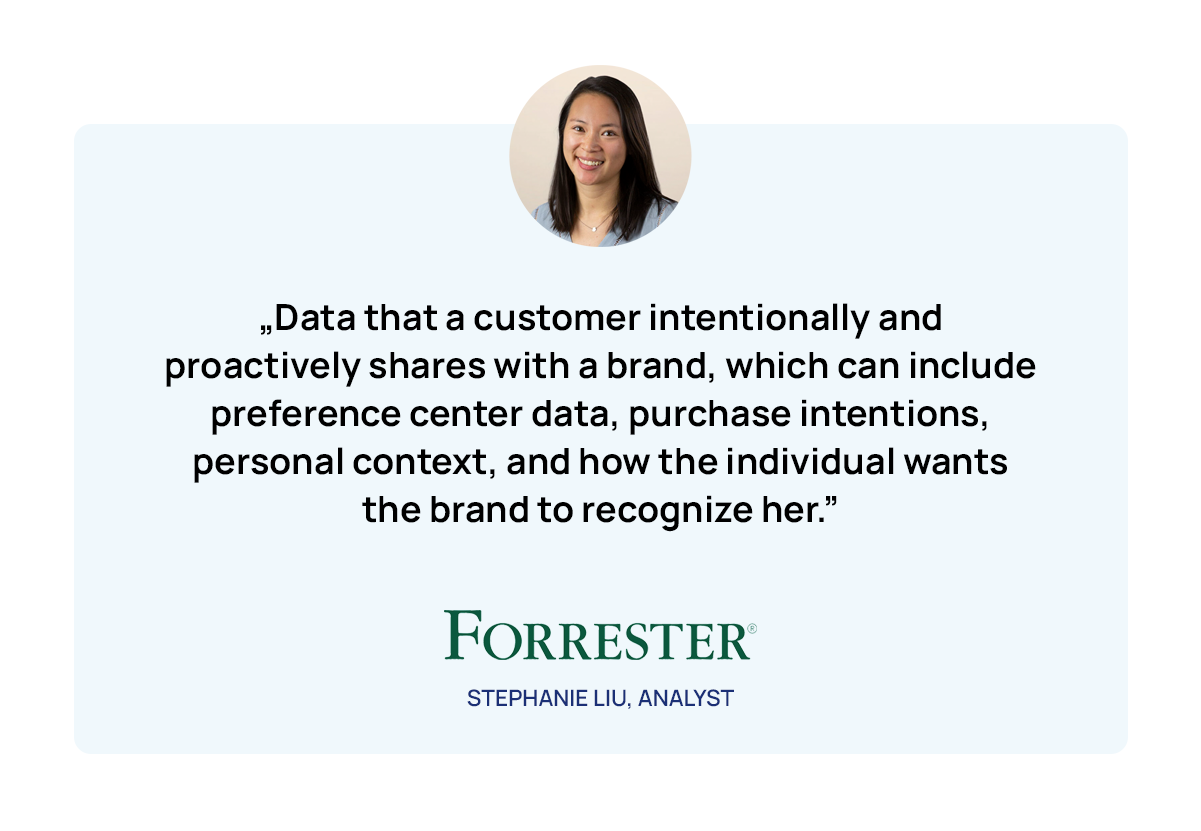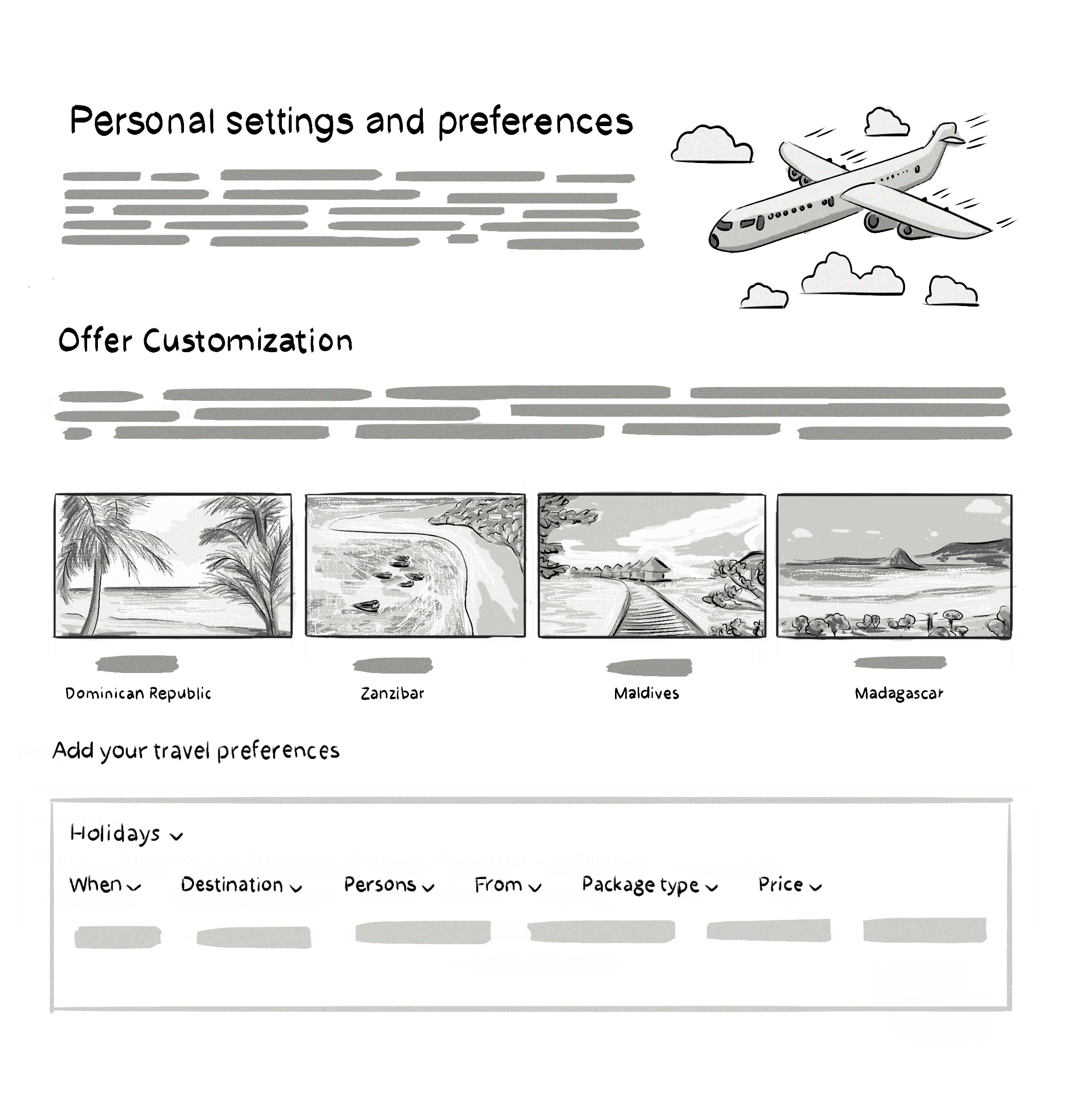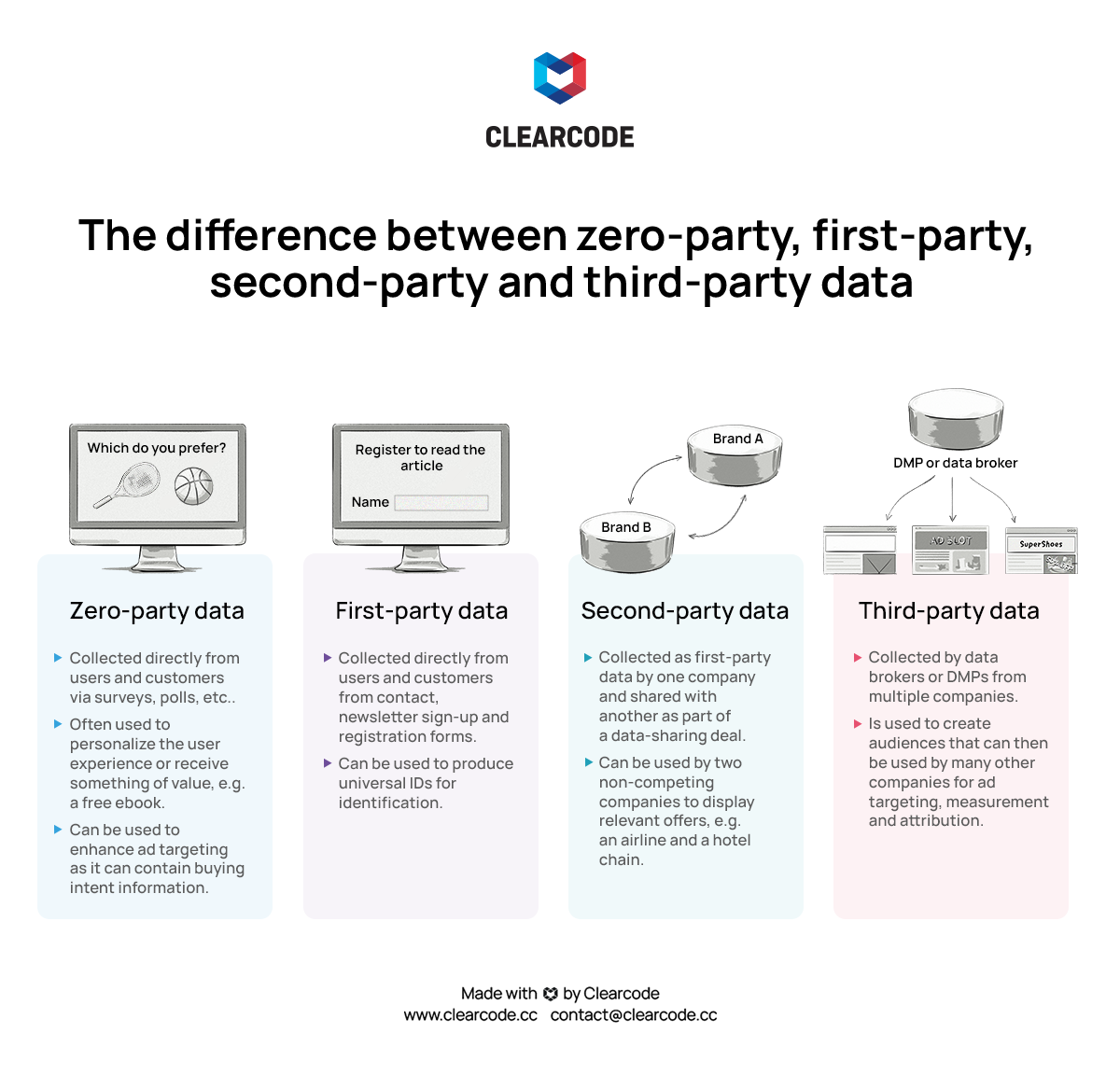In the last few years, Internauts have gained serious protection of their privacy. Strong regulations such as the EU’s GDPR help protect personal data and fine organizations that don’t follow the rules or try to bypass them. Moreover, the era of third-party cookies will end next year when Google Chrome is expected to withdraw its support for third-party cookies.
That’s why marketers, advertisers, and agencies have started to invest in different data strategies to continue offering personalized advertising without relying on third-party data, which has been the standard approach in programmatic advertising.
While many companies are starting to collect and utilize first-party data to power personalization, another type of data is emerging — zero-party data.
In this post, you will learn what zero-party data is, why it’s essential for AdTech, and understand the differences between the three most important data types: zero, first, and third-party data.
Key Points
- Zero-party data is data that customers own and willingly give to brands, for example, to personalize their experience or receive something of value.
- Zero-party data helps match the brand’s offering with the current customer’s needs and develops the business faster and in the right direction.
- Examples of zero-party data include information obtained from customers via newsletter sign-ups, calculators, quizzes, surveys, etc.
- To collect zero-party data, you need to have privacy and data processing policies that comply with current privacy laws, such as the EU’s GDPR. In the gathering process, you can utilize customer engagement platforms and enrich single customer views (SCV) in your customer data platforms (CDP) or customer relationship management systems (CRM).
- To create audiences for ad campaigns, marketers use zero-party, first-party and third-party data.
- The difference between zero-party and first-party data is that ZPD comes directly from a customer to improve their experiences and, for example, get more personalized recommendations, while first-party data comes directly from the customer from other avenues, such as newsletter sign-ups.
What Is Zero-Party Data?
Zero-party data is data that customers willingly give to brands — intentionally and proactively. Generally, users provide companies with their zero-party data to improve their experience on a website or mobile app, such as via polls and surveys. First-party data is collected in various ways, such as via form submissions and web analytics tools.

The term “zero-party data” was coined by Forrester Research, a company that promotes the idea of a customer-centric attitude. In 2020, Forrester pointed out that brands will need to focus on working with the data shared directly from their customers because of the tightening privacy laws and regulations, such as GDPR, CCPA, and Vermont’s data broker registration law.
Typically, the customer will expect something interesting in return for their data — for example, an e-book, a report, an e-mail with interesting content, etc. Collecting first-hand information and permission to use it gives advertisers a more panoramic view of the customer’s preferences, challenges, goals, and interests.
Data Platform Development
We can build a range of data platforms such as customer data platforms (CDPs), data management platforms (DMPs), data clean rooms, data lakes and reporting dashboards.
Why Is Zero-Party Data Important?
To create an advertising campaign that addresses the right audience and the right problems, having information about them is the key. By collecting data directly from consumers about their interests and preferences, advertisers can display more relevant ads to them.
However, zero-party data is essential for a couple more reasons:
- Zero-party data is more trustworthy than third-party data — customers who share their personal information freely with a business and are aware that the information will be utilized for personalization or to improve the user experience are more likely to share honest and helpful data.
- Personalization and customer experience — the customer who is already familiar with or uses services and products of a given brand can submit more information on their preferences to customize recommendations.
- Segmentation — the organization collecting zero-party data can prepare the form in such a way as to obtain the information needed for customer segmentation.
- Data clean room collaboration — companies can share anonymized zero-party data in a data clean room and analyze combined data sets. Based on the analyses, their strategies and activities can be modified. For example, they can prepare a new ad campaign with better targeting criteria.
- Obtaining marketing consent — a potential customer can allow various forms of contact, such as e-mail, telephone, and SMS, when providing their data.


Current trends in the AdTech and MarTech industries are emphasizing the importance of zero-party data. Brands, publishers, and agencies include various data acquisition scenarios in their marketing strategies to obtain more zero-party data.
In the future, brands will need to focus on zero-party data to develop dependable, individualized connections with their customers as consumers’ privacy awareness grows.
Zero-Party Data Examples
There are plenty of tools to collect zero-party data. These can be simple forms next to newsletter sign-ups, calculators, quizzes, surveys — everything in the marketing funnel that helps obtain user information.
In general, brands offer something in exchange for sharing information. Materials that encourage customers to share personal details take various forms as well. These can be free newsletters, e-books, discounts, access to a closed Facebook group, free consultations, better matching of recommended content and items, etc.
How To Collect Zero-Party Data?
As we mentioned, marketers use various strategies to gather information directly from users.
However, organizations must also create appropriate privacy and data processing policies to collect, store, and process zero-party data. For example, European countries are regulated by the General Data Protection Regulation (GDPR) and California has its California Consumer Privacy Act (CCPA).
When creating these policies, organizations must provide answers to several fundamental questions:
- What personal information is being collected?
- How is the information collected?
- Why is the data collected?
- How is the information used?
- Who will have access to the information?
- What choices do you have?
- Can you review or correct the personal information?
- What security measures are used to protect personal information?
- How long will the organization honor its privacy policy?
- Who is accountable for the organization’s privacy practices?
To collect personal information, brands also need to put these policies in a prominent location, for example, in the footer of their website.
If it comes to tech solutions, to collect zero-party data marketers can utilize customer engagement platforms and enrich their single customer views (SCV) in their customer data platforms (CDP) or customer relationship management (CRM) systems with the zero-party data.
What Is First-Party Data?
Another valuable type of data for both advertisers and publishers is first-party data. This data type is collected directly from people who have interacted with the brand, such as customers.

Here are examples of first-party data:
- Data about products people have purchased and the value of orders, which is often collected by ecommerce and offline transactions.
- Personal information such as names, postal and billing addresses, email addresses, and phone numbers — often collected by e-commerce and offline transactions.
- Data about people who have created an account with your business, downloaded a digital product (e.g., an ebook) and purchased something from you. This data is often collected by customer relationship management systems. Like with e-commerce data, this often includes names, phone numbers, and email addresses.
- Data about which pages the user has browsed, videos they’ve watched, and other content interactions, which is often collected by website and mobile app analytics.
The sources of first-party data can originate from online and offline activities.
How Is First-Party Data Used In Programmatic Advertising?
Data has played a key role in programmatic advertising since day one. Advertisers collect data, segment it, create audiences out of it and use it to power ad targeting, measurement, attribution and analysis.
The goal here is to convert visitors into customers, upsell products and services to existing customers using audience-targeted and retargeting campaigns, identify which ad campaigns and channels are delivering the best ROI, and get insights into consumer behavior.
Traditionally, advertisers would use third-party data for audience targeting and measurement as it was readily available via third-party cookies and data brokers.
However, the changing privacy landscape in programmatic advertising has meant that this data is much harder to come by, so advertisers, agencies and publishers have turned their attention to using first-party data for key advertising processes.
For instance, companies operating in the programmatic advertising industry use first-party data, such as an email address from a CRM or CDP to generate an universal ID. This ID is then used to identify that person across the web and show them relevant and targeted ads. In this context, universal IDs are essentially replacing the processes carried out by third-party cookies.
What Is Second-Party Data?
Second-party data, or partner data, is data gathered by one company and sold or exchanged to another. Usually, the other company is a business partner with similar audiences.
An example of this kind of partnership is a travel agency and a hotel chain.
The agency and the hotel chain could exchange information and show ads to similar groups of customers, or one of them could hand over the data so the other could target the campaigns to a specific audience.
Second-party data enables companies and advertisers to connect with an additional, untapped set of potential consumers, making it competitive with first-party data as it contains individuals who are either already customers or have indicated a desire to become one.
What Is Third-Party Data?
Third-party data is collected indirectly from a consumer by a company and is often seen as the least valuable type of data. Companies “stitch” the data together from different sources, such as commercial, academic, non-profit, or governmental websites.
How Is Third-Party Data Created?
In the AdTech world, publishers, ecommerce merchants and app developers who want to monetize their audiences and data add third-party trackers to their websites or tracking SDKs to their apps and pass data about their audiences to data brokers (e.g., marketplaces or exchanges) and data management platform (DMP) vendors.
Data brokers can “stitch” different data sets into audience segments based on interests, purchase preferences, income groups, demographics, etc. They can also enrich these segments with information from offline data providers, such as credit card companies, credit scoring agencies, and telcos.
The main advantage of this data kind is scale — advertising campaigns constructed with third-party data can reach a much bigger audience compared to zero, first or second-party data.

Here are examples of third-party data:
- A user’s browsing history.
- Content interactions.
- Purchases.
- Profile information entered by the user (e.g., gender or age).
- GPS location.
What’s the Difference Between Zero-Party, First-Party and Third-Party Data?
The table below compares zero, first and third-party data by relevance and transparency, accessibility, competitiveness and reach.
| Zero-party data | First-party data | Third-party data | |
|---|---|---|---|
|
Relevance and transparency How closely connected is the audience to the advertiser’s target audience and how transparent is the quality of the data? |
Zero-party data delivers highly valuable information as it’s directly given from consumers. |
First-party data is made up of consumers that either are existing customers or who have engaged with a brand or publisher, meaning the audience is usually already part of the advertiser’s target audience. |
Because third-party data is collected and aggregated from different sources, the direct connection between an advertiser and user is lost. This means the relevance is often low. |
|
Accessibility How easy is it for an advertiser to collect? |
Zero-party data is collected directly from the brand or publisher’s website or app. |
First-party data is collected directly from the brand or publisher’s website or app. |
Once an integration with a DMP or a data broker has been established, you can buy data sets on demand without the need for additional implementation. |
|
Competitiveness What competitive advantage could this type of data provide? |
Zero-party data is given directly by potential customers, existing customers or users, so a brand or publisher can utilize it to personalize content and recommendations, create look-a-like audience segments, generate advanced analytics reports and deliver an excellent user experience. |
As first-party data is exclusively available to the brand or publisher, it can be used for high-converting activities, such as content and ad personalization. |
As third-party data is usually widely accessible, many companies have access to the same pieces of data, meaning third-party data provides less of a competitive edge. |
|
Reach How many people could an advertiser reach by using this type of data? |
Zero-party data is limited to the group of users that passed their data to the publisher or brand. |
First-party data is limited to the visitors of the website (i.e. their online audience) and existing customers (e.g. offline CRM data). |
As data brokers and DMPs aggregate data from multiple partners, they have data on almost every user on the Internet. |
If you want to learn more about the difference between first and third-party data, read this post.
Zero-Party Data vs. First-Party Data: What’s the Difference?
If zero-party data and first-party data can come from the same source, how can you differentiate between them? The answer lies in the reason why a consumer shares the data with a company.
Zero-party data is provided by users because they want to receive a more personalized experience, e.g. content recommendation, whereas first-party data is collected via interactions with an advertiser or publisher, e.g. name, email address, etc. when signing up for a newsletter.
The effects of collecting data in these two different ways vary from each other.
Zero-party data can enhance ad targeting as advertisers and publishers can get better insights into their customer’s current needs and interests.
E.g. if a user fills in a survey and states that they prefer basketball shoes over running shoes, then advertisers can show them more targeted ads.

Data Platform Development
We can build a range of data platforms such as customer data platforms (CDPs), data management platforms (DMPs), data clean rooms, data lakes and reporting dashboards.








